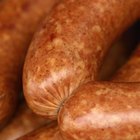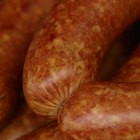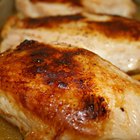fordeno/iStock/GettyImages
Reverse-Searing for Succulent Sausage Success
The road to kielbasa nirvana is paved with pitfalls. It you cook them at too high a temperature, the casing scorches and bursts forth with undercooked sausage stuffing; cook them at too low a temperature, and the stuffing cooks through but the casing wrinkles and grays, not unlike a sad, desiccated common wiener. And you don't even want to know the horrors that await when you slice fresh sausage and then bake it. So how do you navigate the precarious path to sausage success? By using two cooking methods in one: the venerable reverse-sear.
Why Reverse-Searing Works
Reverse-searing, or first baking the kielbasa in a flavorful cooking medium – such as stock, sauerkraut and beer, or onions and peppers – then searing it on the stove for a delectably caramelized finish, covers the spectrum of moist-dry cooking methods. You essentially braise the sausage for nice, even cooking all the way through and then do a quick, high-temperature sear to achieve the hallmark of a well-cooked kielbasa: a richly browned, intact casing.
Cooking Mediums and Secondary Ingredients
You can bake kielbasa with just about any ingredients that produce moisture when heated, which are many. Beer and sauerkraut are almost organic in their relationship with kielbasa, but so is the Italian-American combo of onions and peppers and the Spanish pairing of sausage and tomato-caper sauce. You can even use stock on its own or with your vegetables of choice, such as fingerling potatoes and sliced shallots, or lentils and mushrooms. The only real guideline to follow is to use enough secondary ingredients and/or stock to reach about halfway up the sides of the kielbasa, just as you would when braising meat.
Let the kielbasa reach room temperature.
Heat the oven to 325F, and take the kielbasa out of the fridge 30 to 45 minutes before you want to cook them; room-temperature sausages cook more evenly than cold sausages.
Heat the secondary ingredients. If you're cooking with sauerkraut and lager, for instance, add them to a saucepan and heat them to a simmer; if you start with cold ingredients, it throws off the kielbasa cooking time. The same applies to stock and other ingredients. If you want the secondary ingredients browned, as you might when cooking with peppers and onions, brown them in a saute pan first.
Arrange the kielbasa in a deep roasting pan. Add enough secondary ingredients to reach about halfway up the sausages. Cover the roasting pan with foil.
Bake the kielbasa until they reach 140F, about 20 minutes. Turn the kielbasa over after 10 minutes. You don't have to check the temperature of each kielbasa, just one. Transfer the secondary ingredients to their serving dishes. Next, heat a couple tablespoons of vegetable oil in a saute pan.
Sear the kielbasa on all sides over high heat. Cook the kielbasa until crisp and caramelized, with an internal temperature of 160F to 165F, about 3 minutes total. Kielbasa cooked to 160F will continue cooking to 165F after you take them out of the saute pan. Let the kielbasa rest for about 5 minutes before slicing or serving.
Related Articles

Ways to Cook Beer & Onions With Smoked ...
How to Cook Kielbasa on the Grill
The Best Way to Cook Italian Sausage ...

How Long Do You Smoke Sausage?

How Long Can You Cook Beef Ribs at 300 ...

How Long to Cook Steak at 150 Degrees ...

The Best Way to Cook Kielbasa

How to Make Beef Shank Tender

What Kind of Alcohol Is Good to Cook ...

How to Cook Elk Sausage
How to Cook Fresh Sauerkraut and ...

How to Make Pollo Asado-Marinated ...

How to Blanch Sausage

How to Grill Ground Deer Sausage

How to Make Venison Bratwurst

Do You Need to Boil Sausage Before ...

How to Smoke a Ham in a Bradley Smoker
How to Season Sauerkraut

Do You Cook Sausage First When Pickling ...

How to Cook Sauerkraut and Kielbasa ...
References
Warnings
- Always cook fresh kielbasa to a minimum internal temperature of 165 F.
Writer Bio
A.J. Andrews' work has appeared in Food and Wine, Fricote and "BBC Good Food." He lives in Europe where he bakes with wild yeast, milks goats for cheese and prepares for the Court of Master Sommeliers level II exam. Andrews received formal training at Le Cordon Bleu.